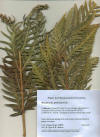|
Woodwardia fimbriata
|
Woodwardia fimbriata |
|
|
|
|
Trees and Shrubs of Kern County (Jan 2013, July 2015) Woodwardia fimbriata J. E. Smith 1818. Giant Chain fern. Fronds erect-spreading from a thick woody underground fibrous stem, to 3 m long, blade-like pinnately divided to near main axis, the ultimate leaflet-like segments (pinnae) sword-shaped, fringed along margins; sori sausage-like aligned along each side of mid-vein, each sorus 2—4 mm within a cavity (areola) and indusiate. Moist or wet places, mostly near coast, British Columbia to Sierra San Pedro Mártir in Baja California, scattered locations inland to Arizona, eastern Nevada. Type from "West coast of North America" "New Georgia" (Tropicos). Common on wet sunny slopes in California. Recognized as an association with bracken fern within the redwood forest alliance (MCV2). Type from Kern Co.: Greenhorn Mts.: Bull Run Creek and Poso Creek Canyon, 838–1219 m (2750–4000 ft), CCH. The common name, chainfern, in regard to the sausage shaped sori aligned almost continuously in two rows on the underside of leaf segments. The genus Woodwardia includes ~13 species distributed in the northern hemisphere. Decoction of roots of “root chainfern,” Woodwardia radicans (Blechnum radicans Linnaeus 1771) J. E. Smith 1793, native to Europe, has been employed by the Luiseño in southern California near Capistrano for alleviating pain from injury (Moerman), An aqueous/ethanol extract of W. virginica (Blechnum virginica Linnaeus 1771) J. E. Smith 1793 collected (Aug 1963) in Georgia showed antitumor activity in the NCI WM assay (May 1968). A glycloside named woodorien, isolated from W. orientalis Swartz 1800 (possibly hybrid cultivar), was reported to have antiviral activity against herpes, polio and measles (Xu et al. 1993). Rhizome and frond samples of W. fimbriata collected in northern California in 1993, and of W. virginica collected in Florida in 1995, sent to Ching-jer-Chang at the School of Pharmacy, Purdue University, reported no activity; the samples relocated to the NCI repository. Woodwardia radicans received an Award of Garden Merit by the British Royal Horticultural Society. Cultivated in California where reportedly escaped in the Sierra Nevada, but not persisting, distinguished from W. fimbriata by the scaly bulblet near base of leaf axil (Cranfill 1993). Species in the genus not drought tolerant, requiring constant wet soil.
|
|
|
Xu, H.X., S. Kadota, M. Kurokawa, K. Shirak, T. Matsumoto and T. Namba. 1993. Isolation and structure of woodorien, a new glucoside having antiviral activity, from Woodwardia orientalis. Chem. Pharm. Bull. (Tokyo) 41(10): 1803-6.
|
|

